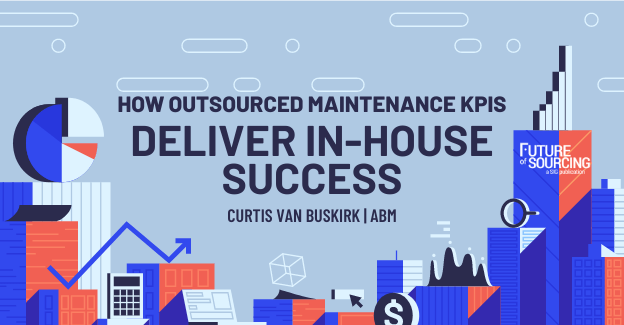How Outsourced Maintenance KPIs Deliver In-House Success
Most everyone relies on daily performance indicators to measure the quality of tools and assets, from large-scale business KPIs such as monthly foot traffic to the personal performance results like the battery life of headphones. While the wrong outcome can be frustrating in any scenario, weak performance in a facility can diminish critical ROI.
It is not difficult to establish and track the indicators of assets and resources that reflect a property’s success. In fact, it is essential in determining if these resources are making the best use of a facility’s budget and its occupants. But when measuring the performance results of facility services partners, it is not always as streamlined. An experienced, proficient vendor can prove their worth by measuring KPIs for their entire portfolio of services – from janitorial, HVAC, and electrical to facilities engineering, mission critical, specialty services and more.
For facility managers interested in outsourcing their services for the first time — or those considering revisiting the venture after being burned before — a facility services partner is out there that can bring the right mix of expertise, scalability, and network of advanced resources and equipment.
A proven vendor can take the headache out of managing facility services while enabling more focus on running core business activities. But do not just take their word for it. Look for a services provider who can offer KPIs in the following areas, all while keeping the interests of its client and team members, occupants, and facility health in mind.
Maintenance Logs
One of the easiest ways to ensure a facility services vendor is doing the job they have been hired is by putting maintenance logs to work. A maintenance log does exactly what it sounds like – records and dates the maintenance or service of an aspect of the facility. Also known as service logs or maintenance records, maintenance logs provide accountability and insight into the current state, upkeep, or system health of the facility on a micro (and with the right analytics, macro) level.
Consumers might be familiar with the type of maintenance log found on the back door of a public bathroom. These maintenance logs and the kind used in facility services are not dissimilar, especially when it comes to a facility’s janitorial program. A maintenance log across all facility restrooms can verify the most hygienic solutions are correctly implemented and the right inventory is present, meaning occupants will never have to face an empty paper towel dispenser.
While records of recurring maintenance are a must for accountability of service and cleanliness in occupant-facing areas, maintenance logs for all systems can help justify preventative or predictive maintenance or signal the urgent need for corrective maintenance. The expert analysis of a facilities services partner, along with the data reflecting the maintenance performed, can enable more accurate time needs like an HVAC fan replacement or identify the point of no return for electrical switchgear, preserving the lifespan of equipment as much as possible.
While a maintenance log should be expected from a reputable vendor, the presence of one should not be taken for granted. The right communication and expectations will dictate the intervals for completing maintenance logs, assessing the data, and anticipating the information being delivered.
Mean Time Between Failures (MTBF) and Routine Preventative Maintenance Schedule
The right KPIs can produce some of the strongest efforts in minimizing system downtime and maximizing efficiencies. With a dedicated partner on-site, facility systems can be carefully and routinely assessed for reliability and performance. Crucial metrics like a system’s mean time between failures (MTBF), or the average amount of time between breakdowns, can help identify weaknesses and patterns in complex assets. The results are then leveraged to determine the reliability of the system and establish a thorough preventative maintenance schedule for the facility services team, allowing them to step in before the next breakdown can occur. If the MTBF is too low and reliability is waning for a given asset, it could be indicative of a system that has run its course.
MTBF results can be used to assess the reliability of a variety of assets across several service lines. The frequency of air quality problems, overloaded circuits, and weak water pressure can be measured to determine system quality and lifespan. A facility restroom alone can face routine plumbing issues from leaky faucets to habitually clogged toilets. Water and dollars wasted from problems like these can be strategically avoided through a robust janitorial offering that uses the right data.
The routine PM schedule that follows can keep a facility clean, efficient, and attractive both inside and out. With well-informed data and a well-equipped team, previously neglected and “low priority” areas can benefit from a regular maintenance schedule. For instance, pressure-washed exteriors, emptied gutters and steam-cleaned carpets and partitions are just some of the aesthetics that a facility can finally improve.
It is important to look for a facility services partner that will take the time to implement a reliable PM schedule and to measure each assets’ worth – not just during the first month of their contract. A consistent, reliable partner will deliver consistently reliable and meaningful results.
Account Governance and Communication
A facility services partner should be just that – a partner in reaching each facility’s goals. While the right data can speak for itself, choosing the right services partner often comes down to intuition. If something feels off, it likely is.
A worthwhile partner will communicate how their efforts can meet both short-term and long-term goals, making the time for a conversation as often as needed. This level of intentionality should not be a nice-to-have; it is a must to help translate high-level mechanical issues into digestible information. While some performance results may speak for themselves, others need to be communicated from service provider to client to keep everyone in the loop to make informed decisions.
A facility services partner that practices active account governance can be the differentiator in choosing a capable but unimpressive facility services vendor – one that does the job as necessary and moves on – with one that helps make a facility the best it can be. Where labor and checkboxes end, a deep level of communication and partnership can begin.
Consider a partner that will regularly meet with leadership teams to share information on key facility needs, energy consumption, and savings opportunities. While a high-quality services partner is supposed to take the burden of facility upkeep off a facility manager’s shoulders, staying informed on the health of the facility can help create better informed decisions, minimize oversight and finger-pointing, and generate higher ROIs.
Tenant Complaint Responses and Conflict Resolution Success
When running a business as large as a commercial property, there is bound to be the occasional issue from occupants, be it an uncalibrated thermostat or a hallway full of faulty lights. With so much on a facility manager’s plate, ensuring tenants’ needs are addressed as quickly and thoroughly as possible will keep the pace of business (from both the tenant’s and facility’s perspective) on the right track.
When considering a facility services partner be sure to inquire about their average request-to-completion turnaround for tenant issues like leaks, electrical repairs, and trash-flow allocation. This KPI will quickly illustrate what services might be helping or hurting a facility’s reputation. It is also important to look at their service request process. A partner with a sophisticated and user-friendly maintenance request dashboard will allow tenants to submit and stay updated on work orders on their own, while enabling the facility manager to monitor the time to turn a request from “pending” to “completed.”
Performance Review Process
While companies are always striving to improve their facilities, a facility services partner should do the same. Just like any successful partnership, the right reflection and self-evaluation can benefit everyone involved. Look for a partner who conducts their own self-review process and aims for continuous improvement across both service and communication. Be sure they offer participation in their evaluation as well as regular satisfaction surveys or quarterly reviews.
This can be a key time to review all of the KPIs above to determine what is working and what is not. Minor adjustments and bigger picture ideas can be brought to the table to keep the services partner aligned with team and culture, so the relationship can do more than maintain.
When Thinking of Outsourcing, Think KPIs
Not all facilities have had the same luck with outsourcing. For those that have had poor experiences in the past or have never committed to outsourcing at all, it can look like a minefield at worst. At best, it can feel like one more thing to worry about. But being arming with the right research, expectations and questions during the selection process can help select the best fit team for both the facility and its occupants.
Consider the above KPIs when entering (or reentering) the outsourcing conversation. Metrics that can be measured and people that can be counted on will make the outsourcing experience a worthwhile one.







